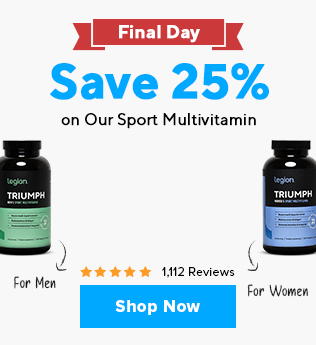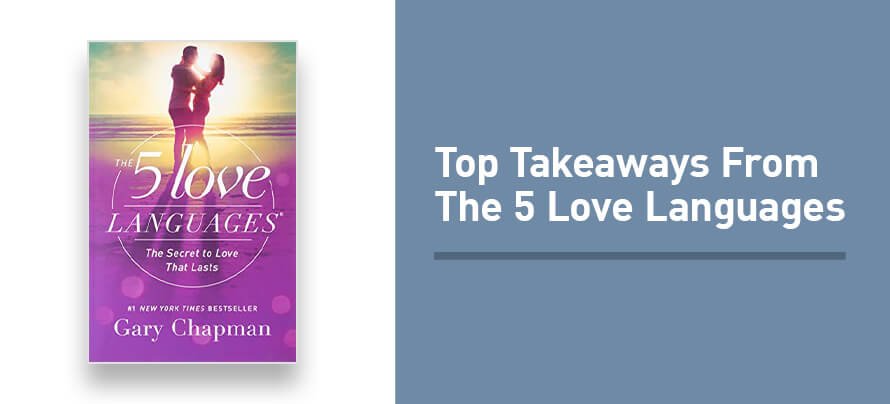[ad_1]
According to bodybuilding purists, if you’re not doing the back squat, you’re wrong.
While you can make your legs “not small” with exercises like the leg press, leg extension, and lunge, they say, you’ll never get the chiseled, tree-trunk legs that result only from the back squat.
Part of the reason the back squat reigns supreme is it’s so freaking hard, making a big squat a rite of passage of sorts for weightlifters.
The back squat requires just about every major muscle group in your body to work in concert to generate a tremendous amount of force, as well as near picture-perfect form if you’re ever going to put up impressive numbers.
You can cheat your way through the bench press and even the deadlift and eventually move heavy loads, but not the back squat. If you don’t have the whole-body strength and technique, there’s no way to wiggle or jigger the weight up. You just get stuck.
A good squat is worth a lot more than bragging rights, though.
It’s also one of the single best exercises for developing every major muscle group in your body, from nosehole to butthole.
That’s only true if you do it correctly, though, which is exactly what you’re going to learn in this article.
By the end, you’ll know what the back squat is, why it’s beneficial, which muscles it works, how to perform proper back squat form, a solid back squat workout, the best back squat alternatives, and more.
What Is a Back Squat?
The back squat (also known as the “barbell back squat,” “bb back squat,” or often just “the squat”) is a lower-body exercise that involves squatting with a barbell lying across your upper back.
Many health and fitness experts consider the back squat the “king of exercises” because no other exercise trains as many muscles simultaneously, helps you gain as much full-body muscle and strength, or is as physically and mentally taxing.
Front Squat vs. Back Squat
What makes the back squat different from the front squat is where you position the bar. In the back squat, you hold the bar in place by creating a “shelf” with your rear delts that the bar lies across, whereas, in the front squat, the bar lies across the front of your shoulders and is held in place against the base of your throat by your hands.
Shifting the weight from the front to the back of your body changes how the exercise feels, which muscles you emphasize, and the amount of weight you can lift.
That said, neither exercise is better or worse than the other. Although both exercises feel quite different, they train the same muscles to a similar degree, so you can use them interchangeably in your workouts.
Of course, there’s no reason to choose just one. The best solution for most people is to include both exercises in your program.
That’s why it doesn’t make sense to think in terms of back squat vs. front squat and instead think in terms of back squat and front squat.
A good way to do this is to include the back squat in your program for 8-to-10 weeks of training, take a deload, then replace the back squat with the front squat for the following 8-to-10 weeks of training.
Then, you can either continue alternating between the exercises every few months like this or stick with the one you prefer.
This is how I personally like to organize my training, and it’s similar to the method I advocate in my fitness books for men and women, Bigger Leaner Stronger and Thinner Leaner Stronger.
(And if you’d like even more specific advice about how you should organize your training to reach your health and fitness goals, take the Legion Strength Training Quiz, and in less than a minute, you’ll know the perfect strength training program for you. Click here to check it out.)
Back Squat: Benefits
1. It trains several major muscle groups.
The back squat is a unique exercise in that it trains almost every major muscle group in your body, excluding your arms, chest, and shoulders.
Specifically, it helps develop your quadriceps, hamstrings, glutes, erector spinae, latissimus dorsi, trapezius, calves, and abs.
2. It improves athletic performance.
The back squat improves your athletic performance in three ways:
- It helps you develop lower-body power, speed, and strength.
- It trains “hip extension” (moving your thighs away from your upper body), which improves your performance in any sport that involves running, jumping, climbing, throwing, sidestepping, and landing.
- It helps you build lower–body stability, making you less prone to injury, so that you can spend more time competing and less time on the sidelines.
3. It allows you to lift heavy weights.
Generally speaking, the more weight you lift, the more strength and muscle you’ll gain.
The back squat allows you to use much heavier weights than most other exercises and causes greater activation of many “supporting” muscle groups, which makes it a fantastic way to build whole-body muscle, strength, and coordination.
It also allows you to progress regularly, which is the best way to maximize the muscle- and strength-building benefits of weightlifting.
Back Squat: Muscles Worked
The main muscles worked by the back squat are the . . .
It also trains your lats, traps, calves, and abs to a lesser degree, too.
Here’s how the muscles worked by the back squat look on your body (sans the abs):
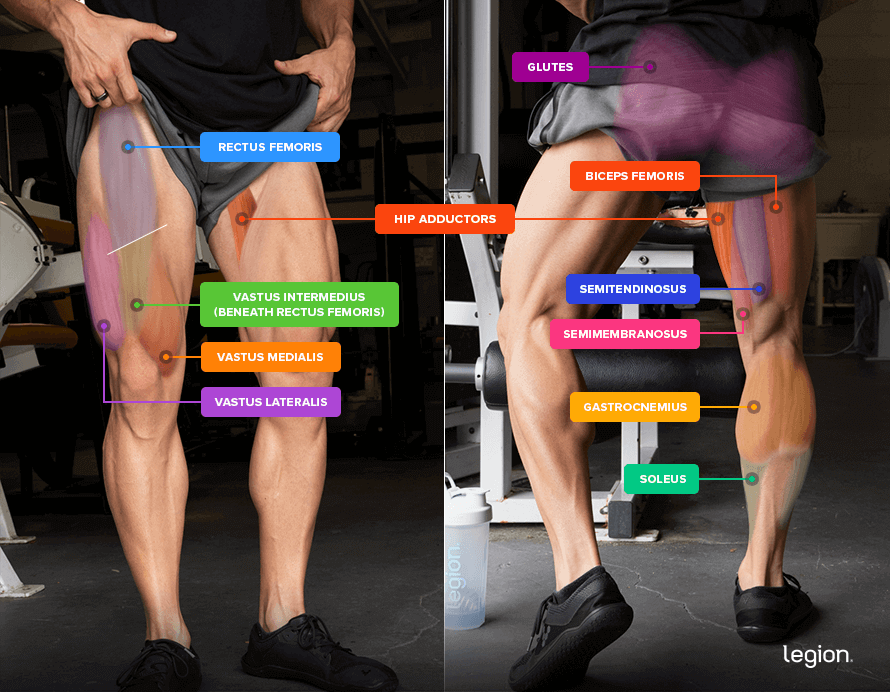

Back Squat: Form
The best way to learn how to back squat is to split the exercise into three parts: set up, descend, and squat.
Step 1: Set Up
Adjust the hooks in a power rack or squat rack so the bar is at the height of your midchest like this:
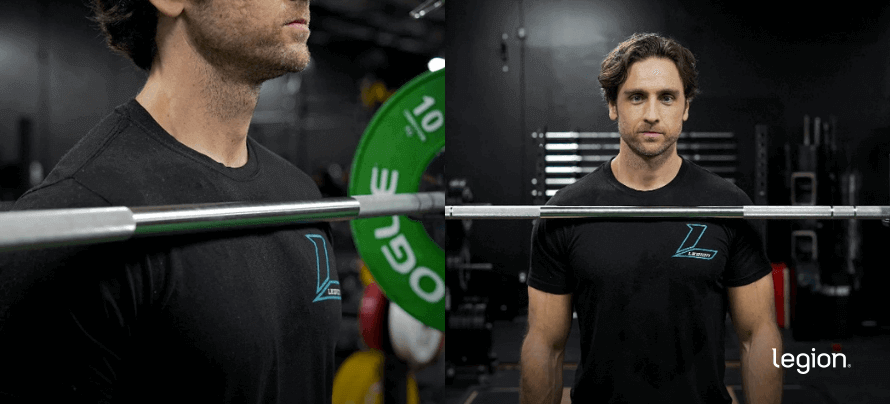
If your squat rack has safety arms or bars, set them to about the height of your midthigh. Load the bar with your desired amount of weight (or not, if the bar alone is enough).
Face the bar so you can walk it out backward. Don’t ever walk the bar out forward, as trying to rerack it by walking backward is dangerous. Get under the bar and position the bar on your back.
There are two ways to do this:
- Using the high-bar position.
- Using the low-bar position.
A high-bar squat has the bar resting directly on the upper traps, whereas a low-bar position has the bar resting between the upper traps and rear deltoids.
Here’s how they look:
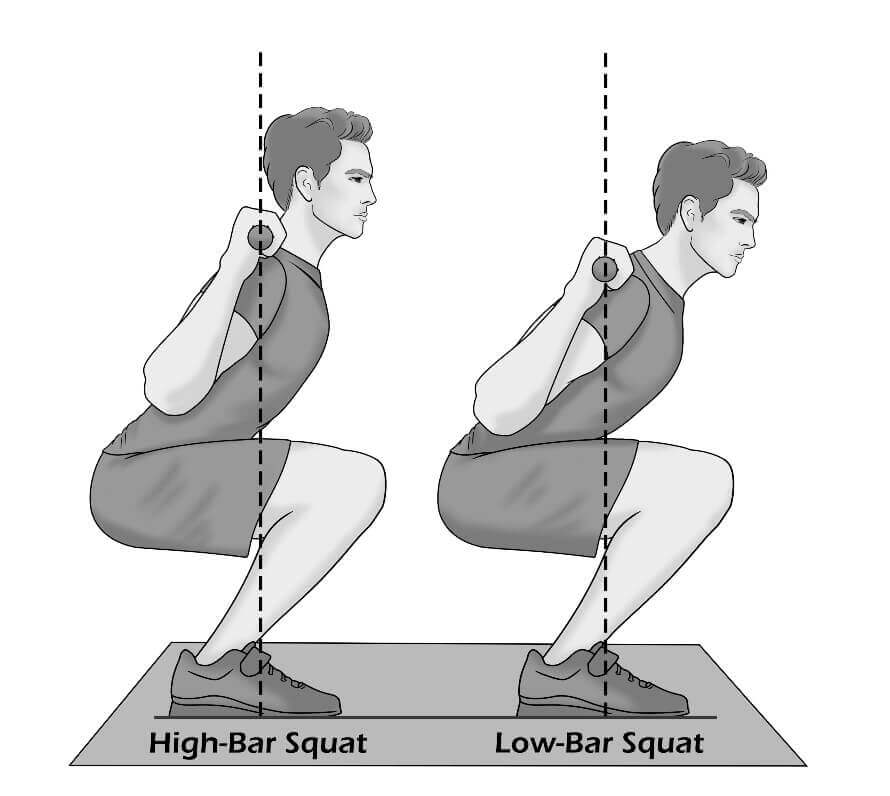
Both methods are correct, but most people will find themselves stronger when they use the low-bar back squat because it allows you to better leverage your large leg muscles. That said, some people find the low-bar back squat uncomfortable for their shoulders or wrists and naturally prefer the high-bar back squat.
If you’re new to the back squat, I recommend you start with the low-bar back squat and only switch to the high-bar back squat if it’s too uncomfortable.
Once you have the bar in your preferred position, grip the bar with your palms facing forward, thumbs on top of or wrapped around the bar, and your hands about 4-to-8 inches wider than shoulder-width apart.
Keeping your palms on the bar, place your feet underneath it a little wider than shoulder-width apart. Then, push your torso under and up against the bottom of the bar, sliding your back up until the bar rests against the back of your shoulders. Pull your shoulder blades together and down to create a little “shelf” out of the bony protrusions of your shoulder blades, and then maneuver your torso so the bar nestles into this shelf.
You may need to narrow or widen your grip to find the correct position. The weight of the bar should be resting almost entirely on your back muscles, not in your hands or on your spine.
Unrack the bar by standing up and taking one step back with each foot (one at a time). Adjust your feet so they’re a little wider than shoulder-width apart and point your toes out about 20-to-25 degrees (around one and eleven o’clock).
The weight should feel evenly balanced over the middle of your feet, not primarily over your toes or your heels.
Here’s what you should look like from the front and back:
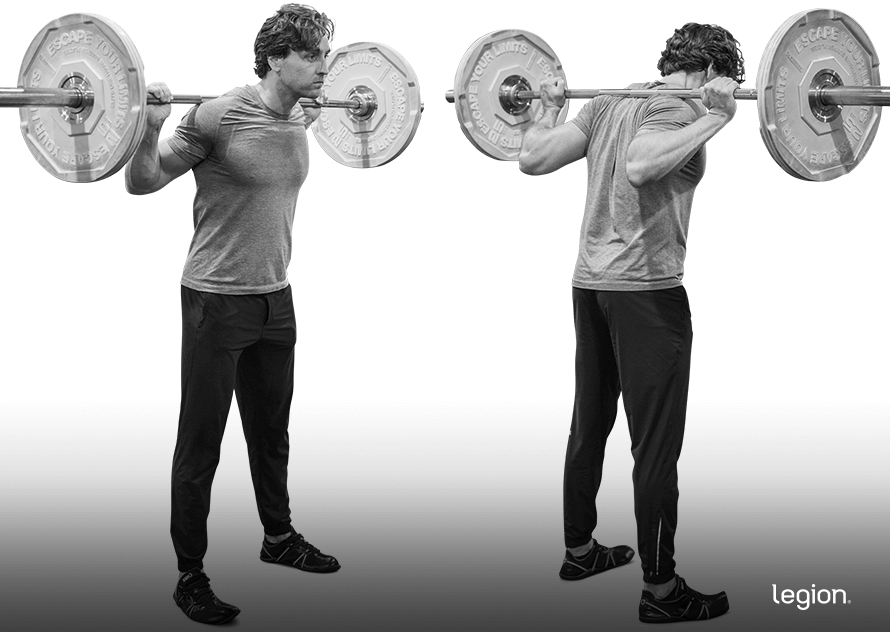
Step 2: Descend
Take a deep breath into your stomach, push your chest out, brace your abs, and sit down by pushing your hips backward and bending your knees at the same time. Keep sitting down until your thighs are parallel to the floor or slightly lower.
Here’s how you should look at the bottom of the back squat:
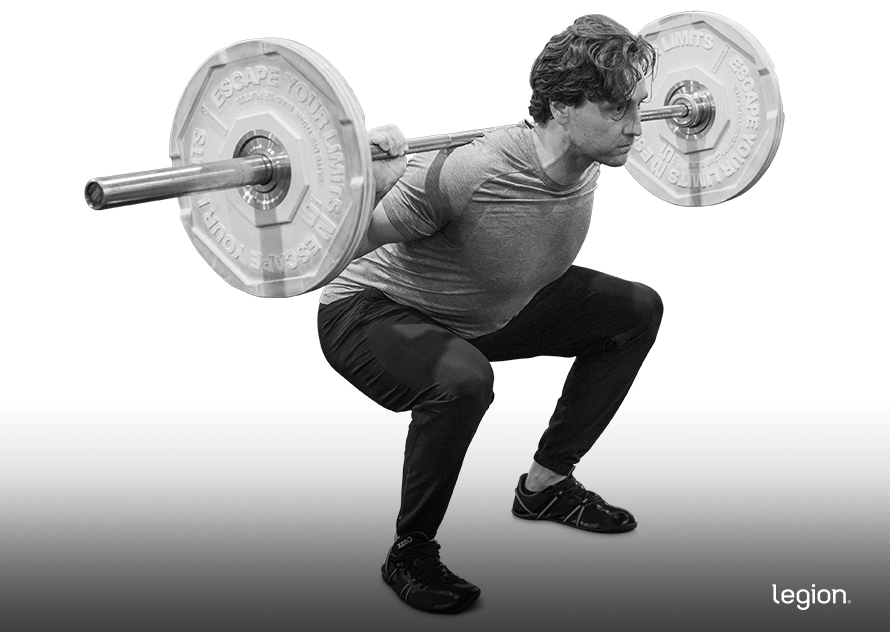
Step 3: Squat
Start the ascent by driving your feet into the floor, ensuring your shoulders move upward at the same rate as your hips—a mirror image of what you did during the descent. About halfway up, push your hips forward and underneath the bar to return to the starting position.
Here’s how it should look when you put it all together:

The Best Back Squat Workout for Strength and Hypertrophy
Here’s an effective leg workout that prioritizes the back squat and also includes other exercises that train all of your lower-body muscles:
- Barbell Back Squat: 3 sets of 4-to-6 reps with 2-to-3 min rest
- Romanian Deadlift: 3 sets of 4-to-6 reps with 2-to-3 min rest
- Leg Press: 3 sets of 6-to-8 reps with 2-to-3 min rest
- Hamstring Curl: 3 sets of 8-to-10 reps with 2-to-3 min rest
The Best Back Squat Alternatives
1. Front Squat
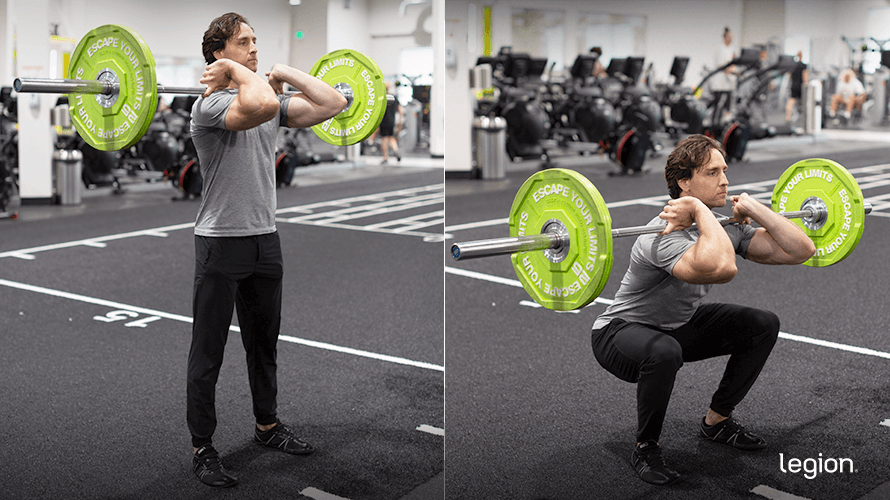
Research shows that the front squat trains the quads about as effectively as the back squat, even when you use up to 20% less weight. What’s more, the front squat also places less compressive forces on your knees and lower back, which make it a particularly good alternative to back squats for people who have knee or back issues.
2. Bulgarian Split Squat
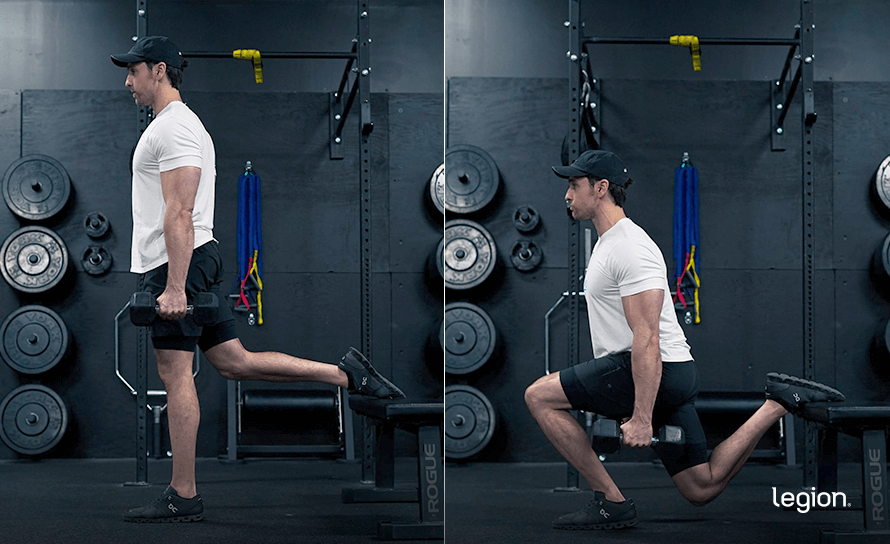
Research shows that the Bulgarian split squat is a great exercise for your entire lower body. Because the Bulgarian split squat trains just one leg at a time, it’s particularly useful for identifying and evening out any muscle or strength imbalances you might have, too.
2. Dumbbell Back Squat
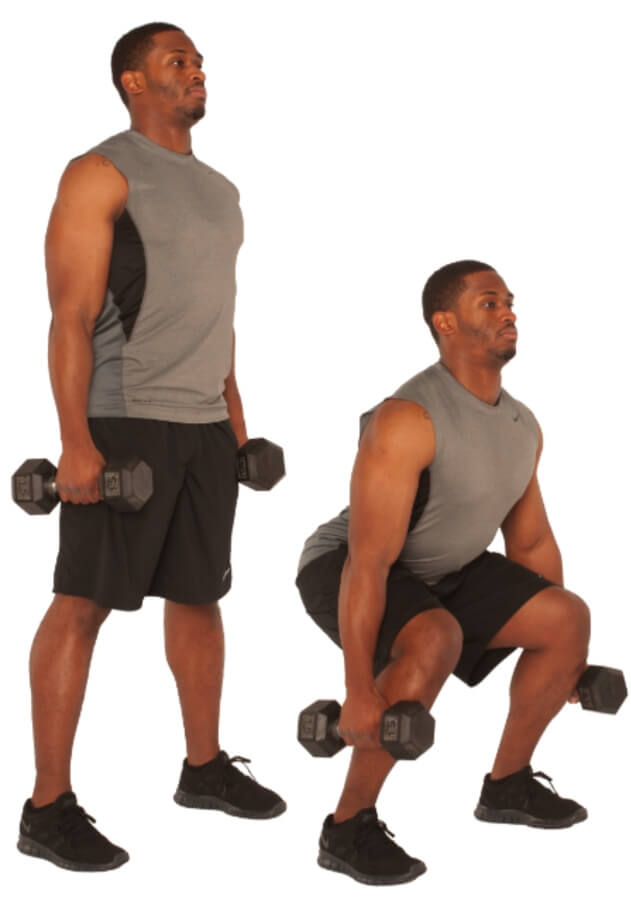
The back squat with dumbbells trains your lower body in a similar way to the barbell back squat—the only difference is you hold dumbbells by your sides rather than place a barbell on your back.
The dumbbell back squat works well if you don’t have a barbell (as during home workouts), but it can feel awkward once the weights get heavy, which is why you’ll generally get more mileage out of the barbell variation.
3. Safety Bar Squat
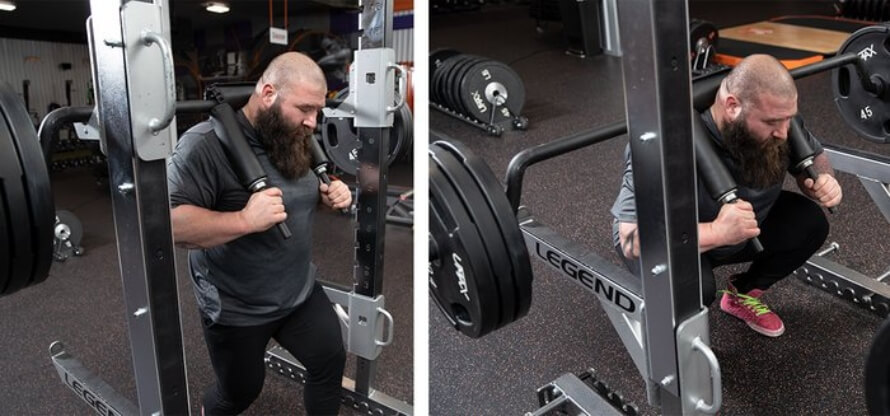
The safety bar squat is a squat variation that involves using a safety squat bar—a special kind of cambered barbell with handles and pads for your back and shoulders.
The safety bar squat is easier on your shoulders and lower back than the back squat, which makes it a good back squat alternative if you have poor shoulder mobility or lower-back issues that make performing the back squat uncomfortable. That said, the safety bar squat doesn’t train your lower body and abs as well as the back squat, making the regular back squat better for gaining muscle and strength overall.
5. Goblet Squat
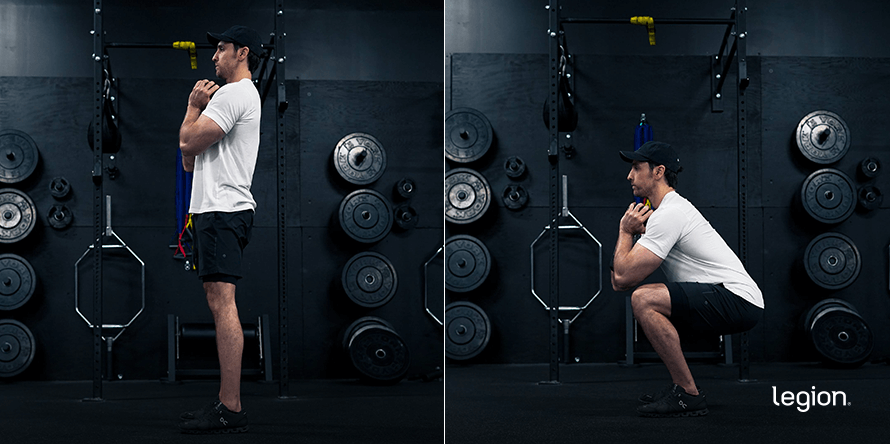
Research shows that the goblet squat is an effective exercise for training all of your lower-body muscle, and particularly your quads. Because you hold the weight in your hands rather than across your shoulders, it’s also easier on your back than other squat variations.
Unfortunately, you can’t lift as much weight with the goblet squat as you can with the back squat, making the exercise less effective for gaining muscle and strength.
FAQ #1: What’s the world record back squat?
The heaviest squat ever performed at an officiated event is 1,311 pounds (~595 kilograms), which was performed by Nathan “Tractor” Baptist in 2021.
While it’s definitely not cause to discount this effort, Baptist’s record was set while wearing several pieces of supportive equipment that helped him squat such a howling weight.
Some people also question whether this is a legitimate back squat world record because footage of the feat makes it look as though Baptist didn’t squat deep enough (his hip crease didn’t go below his knee joint), but the judge at the event ruled that he hit the required depth for the lift to count.
The back squat world record for a “raw” weightlifter (a weightlifter who only uses a belt, chalk, wrist wraps, and knee sleeves) is 1,080 pounds (490 kilograms), set by Ray Williams.
FAQ #2: Why does my lower back hurt when I squat?
Here are three probable causes and some pointers on how to fix them:
- You’re using incorrect technique: There are countless ways you can mess up back squat technique and put undue stress on your spine. Fortunately, the fix is simple: use the information in this article to learn proper back squat form and stick to it. (A common mistake is letting your chest fall forward, putting your lower-back in a compromised position.)
- You’re not flexible enough: It’s common for people with poor hamstring and ankle mobility to round their back when they reach the bottom of the squat, which can cause back pain or lead to an injury. The best way to remedy this is to improve your lower-body mobility using the information in this article:
How to Improve Flexibility and Mobility for Squatting - You have a preexisting lower-back injury: If you have a preexisting injury that makes back squatting uncomfortable, you have two options: stop performing the back squat until your back is fully healed, or stop doing the back squat altogether and replace it with an exercise that trains your muscles in a similar way but doesn’t hurt your back (and if you take an extended break, you can always try to back squat again later—it’s rare that someone has to give up the back squat forever).
FAQ #3: What are the best squat alternatives for a bad back?
If you suffer from back squat back pain and want to substitute the back squat for an alternative that trains the same muscles but doesn’t put as much strain on your lower back, either use the back squat alternatives given above or use a machine exercise like the hack squat or leg press.
FAQ #4: Goblet Squat vs. Back Squat: Which is better?
It depends.
The back squat allows you to lift heavy weights safely, which means it’s generally better for building muscle and gaining strength.
That said, the goblet squat is easier to learn and allows you to lift weights that are lighter than a barbell (which might be too heavy when you first start weightlifting), making it more suitable for beginners.
FAQ #5: Safety Bar Squat vs. Back Squat: Which is better?
It depends.
Most people can lift more weight on the back squat than the safety bar squat and the back squat trains more muscles than the safety bar squat, which means the back squat is generally better for building muscle and gaining strength.
The safety bar squat has a few unique advantages, though.
It’s kinder to your shoulders and lower back than the back squat and it makes “hitting depth” (getting your hip below the height of your knee joint at the bottom of the squat) easier. This means the safety bar squat is a viable squat variation for people with shoulder and lower back issues or poor mobility.
FAQ #6: Hack Squat vs. Back Squat: Which is better?
It depends.
The hack squat and back squat are both effective exercises for training all the muscles of the legs, though the back squat is likely better at training stabilizer muscles across your entire body and secondary muscle groups such as the lower back, and may have more carryover to other athletic endeavors.
That said, some people lack the mobility to perform the back squat properly, or can’t perform the back squat because of preexisting injuries that make it unsafe to place heavy loads on their back.
For these people, the hack squat is a better option, at least until they develop the mobility to perform the back squat with proper form or recover from the injury that makes squatting uncomfortable.
In most cases, there’s no reason to choose just one of these exercises, though. The best solution for most people is to include both exercises in your program.
A good way to do this is to start your leg workout with the back squat, then perform the hack squat later in your workout when supporting muscles like your lower back are bushed, but your legs can probably manage another few sets.
(This is also the method I recommend in my fitness books for men and women).
FAQ #7: Is the Smith machine back squat a good back squat alternative?
The Smith machine back squat isn’t as effective at developing your lower-body muscles as the barbell back squat, but it’s a workable back squat alternative if you don’t have access to a barbell, you’re working around an injury, or you simply don’t want to do the barbell version.
FAQ #8: Which supplements will boost my back squat performance?
No supplements will add 20 pounds to your back squat overnight, but the right ones can help you perform at your best (and if you’d like specific advice about exactly what supplements to take to reach your fitness goals, take the Legion Supplement Finder Quiz).
Here are the best supplements for supporting your back squat workouts:
- 0.8-to-1.2 grams of protein per pound of body weight per day. This provides your body with the “building blocks” it needs to build and repair muscle tissue and help you recover from your workouts. If you want a clean, convenient, and delicious source of protein, try Whey+ or Casein+.
- 3-to-5 grams of creatine per day. This will boost muscle and strength gain, improve anaerobic endurance, and reduce muscle damage and soreness from your workouts. If you want a 100% natural source of creatine that also includes two other ingredients that will help boost muscle growth and improve recovery, try Recharge.
- One serving of Pulse per day. Pulse is a 100% natural pre-workout drink that enhances energy, mood, and focus; increases strength and endurance; and reduces fatigue. You can also get Pulse with caffeine or without.
+ Scientific References
- Coratella, G., Tornatore, G., Caccavale, F., Longo, S., Esposito, F., & Cè, E. (2021). The Activation of Gluteal, Thigh, and Lower Back Muscles in Different Squat Variations Performed by Competitive Bodybuilders: Implications for Resistance Training. International Journal of Environmental Research and Public Health, 18(2), 1–11. https://doi.org/10.3390/IJERPH18020772
- Myer, G. D., Kushner, A. M., Brent, J. L., Schoenfeld, B. J., Hugentobler, J., Lloyd, R. S., Vermeil, A., Chu, D. A., Harbin, J., & McGill, S. M. (2014). The back squat: A proposed assessment of functional deficits and technical factors that limit performance. Strength and Conditioning Journal, 36(6), 4. https://doi.org/10.1519/SSC.0000000000000103
- Krause Neto, W., Soares, E. G., Vieira, T. L., Aguiar, R., Chola, T. A., Sampaio, V. de L., & Gama, E. F. (2020). Gluteus Maximus Activation during Common Strength and Hypertrophy Exercises: A Systematic Review. Journal of Sports Science & Medicine, 19(1), 195. /pmc/articles/PMC7039033/
- Kirkpatrick, J., & Comfort, P. (2013). Strength, power, and speed qualities in english junior elite rugby league players. Journal of Strength and Conditioning Research, 27(9), 2414–2419. https://doi.org/10.1519/JSC.0B013E3182804A6D
- Wisløff, U., Castagna, C., Helgerud, J., Jones, R., & Hoff, J. (2004). Strong correlation of maximal squat strength with sprint performance and vertical jump height in elite soccer players. British Journal of Sports Medicine, 38(3), 285–288. https://doi.org/10.1136/BJSM.2002.002071
- Seitz, L. B., Reyes, A., Tran, T. T., de Villarreal, E. S., & Haff, G. G. (2014). Increases in lower-body strength transfer positively to sprint performance: a systematic review with meta-analysis. Sports Medicine (Auckland, N.Z.), 44(12), 1693–1702. https://doi.org/10.1007/S40279-014-0227-1
- Delgado, J., Drinkwater, E. J., Banyard, H. G., Haff, G. G., & Nosaka, K. (2019). Comparison Between Back Squat, Romanian Deadlift, and Barbell Hip Thrust for Leg and Hip Muscle Activities During Hip Extension. Journal of Strength and Conditioning Research, 33(10), 2595–2601. https://doi.org/10.1519/JSC.0000000000003290
- Behrens, M. J., & Simonson, S. R. (2011). A comparison of the various methods used to enhance sprint speed. Strength and Conditioning Journal, 33(2), 64–71. https://doi.org/10.1519/SSC.0B013E318210174D
- Achalandabaso-Ochoa, A., Aibar-Almazán, A., Martínez-Amat, A., Pecos-Martín, D., Vidal-Aragón, G., Calderón-Corrales, P., Acuña, Á., & Gallego-Izquierdo, T. (2020). Effects of a Gluteal Muscles Specific Exercise Program on the Vertical Jump. International Journal of Environmental Research and Public Health, 17(15), 1–11. https://doi.org/10.3390/IJERPH17155383
- Bartlett, J. L., Sumner, B., Ellis, R. G., & Kram, R. (2014). Activity and functions of the human gluteal muscles in walking, running, sprinting, and climbing. American Journal of Physical Anthropology, 153(1), 124–131. https://doi.org/10.1002/AJPA.22419
- Plummer, H. A., & Oliver, G. D. (2014). The relationship between gluteal muscle activation and throwing kinematics in baseball and softball catchers. Journal of Strength and Conditioning Research, 28(1), 87–96. https://doi.org/10.1519/JSC.0B013E318295D80F
- Houck, J. (2003). Muscle activation patterns of selected lower extremity muscles during stepping and cutting tasks. Journal of Electromyography and Kinesiology : Official Journal of the International Society of Electrophysiological Kinesiology, 13(6), 545–554. https://doi.org/10.1016/S1050-6411(03)00056-7
- Struminger, A. H., Lewek, M. D., Goto, S., Hibberd, E., & Blackburn, J. T. (2013). Comparison of gluteal and hamstring activation during five commonly used plyometric exercises. Clinical Biomechanics (Bristol, Avon), 28(7), 783–789. https://doi.org/10.1016/J.CLINBIOMECH.2013.06.010
- Escamilla, R. F. (2001). Knee biomechanics of the dynamic squat exercise. Medicine and Science in Sports and Exercise, 33(1), 127–141. https://doi.org/10.1097/00005768-200101000-00020
- Hartmann, H., Wirth, K., & Klusemann, M. (2013). Analysis of the load on the knee joint and vertebral column with changes in squatting depth and weight load. Sports Medicine (Auckland, N.Z.), 43(10), 993–1008. https://doi.org/10.1007/S40279-013-0073-6
- National Strength and Conditioning Association Journal. (n.d.). N.S.C.A. POSITION PAPER: The Squat Exercise in Athletic Cond… : Strength & Conditioning Journal. Retrieved May 19, 2022, from https://journals.lww.com/nsca-scj/Citation/1991/10000/N_S_C_A__POSITION_PAPER__The_Squat_Exercise_in.11.aspx
- T M McLaughlin, T J Lardner, & C J Dillman. (n.d.). Kinetics of the parallel squat – PubMed. Retrieved May 19, 2022, from https://pubmed.ncbi.nlm.nih.gov/725284/
- Myer, G. D., Brent, J. L., Ford, K. R., & Hewett, T. E. (2011). Real-time assessment and neuromuscular training feedback techniques to prevent ACL injury in female athletes. Strength and Conditioning Journal, 33(3), 21. https://doi.org/10.1519/SSC.0B013E318213AFA8
- Miletello, W. M., Beam, J. R., & Cooper, Z. C. (2009). A biomechanical analysis of the squat between competitive collegiate, competitive high school, and novice powerlifters. Journal of Strength and Conditioning Research, 23(5), 1611–1617. https://doi.org/10.1519/JSC.0B013E3181A3C6EF
- Yavuz, H. U., Erdağ, D., Amca, A. M., & Aritan, S. (2015). Kinematic and EMG activities during front and back squat variations in maximum loads. Journal of Sports Sciences, 33(10), 1058–1066. https://doi.org/10.1080/02640414.2014.984240
- Gullett, J. C., Tillman, M. D., Gutierrez, G. M., & Chow, J. W. (2009). A biomechanical comparison of back and front squats in healthy trained individuals. Journal of Strength and Conditioning Research, 23(1), 284–292. https://doi.org/10.1519/JSC.0B013E31818546BB
- Jones, M. T., Ambegaonkar, J. P., Nindl, B. C., Smith, J. A., & Headley, S. A. (2012). Effects of unilateral and bilateral lower-body heavy resistance exercise on muscle activity and testosterone responses. Journal of Strength and Conditioning Research, 26(4), 1094–1100. https://doi.org/10.1519/JSC.0B013E318248AB3B
- Slater, L. V., & Hart, J. M. (2017). Muscle Activation Patterns during Different Squat Techniques. Journal of Strength and Conditioning Research, 31(3), 667–676. https://doi.org/10.1519/JSC.0000000000001323
- Hecker, K. A., Carlson, L. A., & Lawrence, M. A. (2019). Effects of the Safety Squat Bar on Trunk and Lower-Body Mechanics During a Back Squat. Journal of Strength and Conditioning Research, 33 Suppl 1, S45–S51. https://doi.org/10.1519/JSC.0000000000002912
- Collins, K. S., Klawitter, L. A., Waldera, R. W., Mahoney, S. J., & Christensen, B. K. (2021). Differences in Muscle Activity and Kinetics Between the Goblet Squat and Landmine Squat in Men and Women. Journal of Strength and Conditioning Research, 35(10), 2661–2668. https://doi.org/10.1519/JSC.0000000000004094
- Schwanbeck, S., Chilibeck, P. D., & Binsted, G. (2009). A comparison of free weight squat to Smith machine squat using electromyography. Journal of Strength and Conditioning Research, 23(9), 2588–2591. https://doi.org/10.1519/JSC.0B013E3181B1B181
- Stokes, T., Hector, A. J., Morton, R. W., McGlory, C., & Phillips, S. M. (2018). Recent Perspectives Regarding the Role of Dietary Protein for the Promotion of Muscle Hypertrophy with Resistance Exercise Training. Nutrients, 10(2). https://doi.org/10.3390/NU10020180
- Branch, J. D. (2003). Effect of creatine supplementation on body composition and performance: a meta-analysis. International Journal of Sport Nutrition and Exercise Metabolism, 13(2), 198–226. https://doi.org/10.1123/IJSNEM.13.2.198
- Eckerson, J. M., Stout, J. R., Moore, G. A., Stone, N. J., Iwan, K. A., Gebauer, A. N., & Ginsberg, R. (2005). Effect of creatine phosphate supplementation on anaerobic working capacity and body weight after two and six days of loading in men and women. Journal of Strength and Conditioning Research, 19(4), 756–763. https://doi.org/10.1519/R-16924.1
- Bassit, R. A., Pinheiro, C. H. D. J., Vitzel, K. F., Sproesser, A. J., Silveira, L. R., & Curi, R. (2010). Effect of short-term creatine supplementation on markers of skeletal muscle damage after strenuous contractile activity. European Journal of Applied Physiology, 108(5), 945–955. https://doi.org/10.1007/S00421-009-1305-1
[ad_2]
Source link


